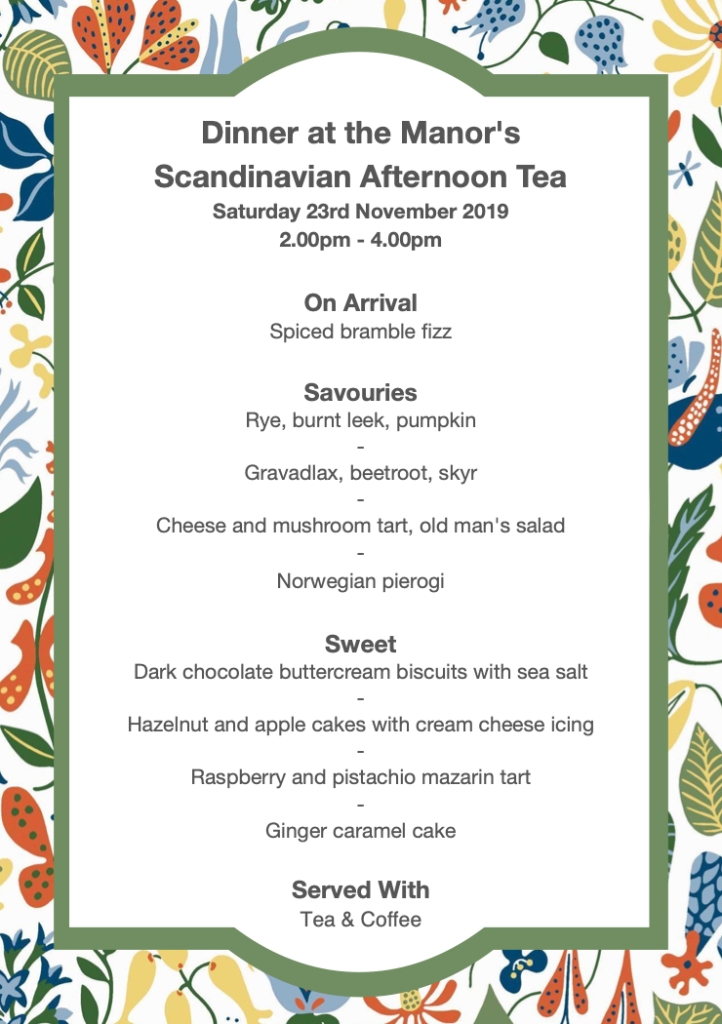It’s a couple of weekends ago now but at the end of September we brought hygge to the Manor through our Scandinavian Comfort Food events. We love anything Scandi and the dishes we prepared seemed an apt way to welcome in Autumn. We used some of our favourite Scandi cookbooks as our inspiration.
I wanted to serve aquavit to guests as a welcome tipple, but subsequently couldn’t find any that wasn’t going to break the bank – so I made my own! It’s actually pretty easy to do – simply infuse a good quality vodka with lemon peel, dill, star anise, caraway and fennel seed. It only needs a few days and then strain and chill. It does pack a punch, but I like my booze to be adult!

Our canapés were home cured gravadlax on little rye crackers, served with a creamy mustard and dill sauce. A classic Scandi combination. This was swiftly followed by a cute little frying pan holding a mini open rye sandwich of bacon and quail egg. This was given a Scandi twist with lots of mustard, dill, kale and a dash of truffle oil.


Our first starter was a comforting broth of celeriac and apple and little Swedish meatballs. The meatballs were flavoured with fennel and nutmeg and the broth was finished off with a pretty green dill oil and tangy cloudberry jam.

Next up was a light salad of roasted beetroot, pearled spelt and whipped goats cheese topped with hazelnuts. Another traditional combination, but a riot of vibrant colours, textures and flavours spiked with fennel and raspberry vinegar.

The fish course came courtesy of our Swedish food crush Niklas Ekstedt. In his amazing Stockholm restaurant he cooks everything over open fire and it’s one of the best meals we’ve ever had. His book is lots of fun, but not particularly accessible. I did his hay flamed cod – gently roasted cod was covered in hay at the last minute and then blowtorched. This imparted a lovely smoky flavour and the odd bit of sweet ash! This was served up with a filthy brown butter sauce and potatoes roasted with miso. Pickled cucumber with pink peppercorn helped cut through the extreme sweetness. The flavours were a great balance of sweet, salty, sour and umami. It’s a very special dish that I’ll cook again next time I want to show off a bit! There was lots of plate licking action in the dining room.



The meat course was a rye crusted lamb leg, boned and rolled then coated in a herb and mustard rye crumb crust, served with a classic Swedish Jansson’s temptation. Floury potatoes, cut into matchsticks, with fried onions, thick cream and the umami boost of pickled sprats (Swedish anchovies) baked in the oven. To cut through the rich lamb and the creamy potatoes, this was served with a simple salad of kale and lingonberries. A little early, but it looked like Christmas on a plate!

Dessert this month was Susie’s take on the traditional Scandi dish of Riskrem, which is cold rice pudding and sour cherries. It was Susie’s turn to use the blowtorch and she turned this into a brûléed rice pudding. The cherries were turned into a cherry gel, alongside some fresh cherries and almonds to bring this old school dessert bang up to date. However, we did keep to some Scandi traditions and kept a whole almond in the middle of one brûlée. The lucky recipient of this went home with a prize (as is the tradition at Christmas with this dessert!)

Finally our not so petit fours were mini marzipan cakes. These were nutty, sweet, moist and chewy and topped with a light crème fraiche frosting and some lingonberries – the perfect fika treat with a coffee!

Next up will be our 6th birthday event, a foray into Cyprus and Turkey, courtesy of our other food crush Selin Kiazim of Oklava. We’ve already started planning the menu and hunting down the obscure ingredients so watch this space for more news of that!


































